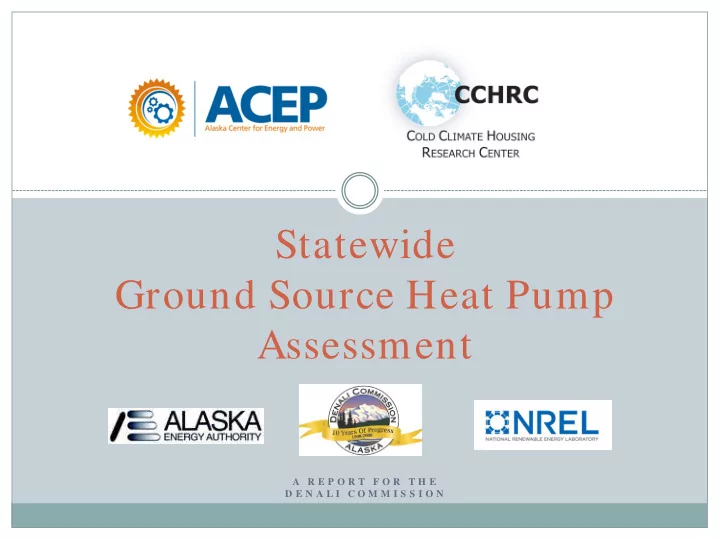

Statewide Ground Source Heat Pump Assessment A R E P O R T F O R T H E D E N A L I C O M M I S S I O N
Report Overview GSHP technology used extensively in the Lower 48 and internationally Limited cold climate applications Little is known about GSHP technology in AK GSHP technology could be very useful to AK, given heating costs in the state
Report Overview 1 st cut assessment What projects were/ are installed in Alaska What does the industry look like What research has been done, either in AK or other cold climates What are the challenges associated with cold climate applications Data analysis with any available project data What are the preliminary economics of GSHP in AK?
Report Overview Assessment divided between three major tasks: Task 1: Information review, synthesis, and identification of knowledge gap Task 2: Database of existing GSHP installations in Alaska Task 3: Preliminary economic assessment
Technology Primer – Heat Pump Source: Gibson, S. / Fine Hom ebuilding
Technology Primer – Heat Pump Familiar technology, different application: Fridge or air conditioner Space heat by air or hydronic Partial load for hot water Source: Gibson, S. / Fine Hom ebuilding
Technology Primer – Ground Loop Source: Bonnie Berkow itz and Laura Stanton/ The Washington Post
Technology Primer – Ground Loop Many options: Vertical well or field of wells Shallow trench in soil Coil on lake bottom Open system drawing groundwater Source: Bonnie Berkow itz and Laura Stanton/ The Washington Post
Technology Primer – Efficiency Metric For heating - Coefficient of Performance (“COP”) COP = Heat output / Power consumption Source: Technical Inform ation, Heat Pum ps/ Viessm ann
Technology Primer – Efficiency Metric Source: Technical Inform ation, Heat Pum ps/ Viessm ann
Task 1: Literature Findings from Alaska Study Duration Heat Source COP Financial Soil Therm al Maintenance Analysis Response Problem s Zarling (1976) - Treated 3.7 (SPF) Favorable - - wastewater Jacobsen (1980) - Water of 2.25-2.5 Comparable to - Possible with sea variable source other systems water Nielsen and 1 ½ year Soil 2-3 - Favorable None Zarling (1983) Juneau WSHP 3 year Sea water 2.53 Favorable - None Program (1984) Williams and 1 winter Soil 2.0 Not favorable More heat pipes Few Zarling (1994) needed if heat load increases Mueller and 1 winter Lake water and 2.16-3.89 - Need longer study None Zarling (1996) soil McFadden 15 years Soil - - Permafrost Several (2000) maintained
Task 1: Summary of Findings Adequate system design is critical Success of a system is location dependent Hybrid applications may enable adoption
Task 1: Summary of Findings High capital costs hinder the technology Lack of developed market in Alaska Lack of long-term research studies
Task 1: Summary of Findings Thermal imbalance in soil is possible Nevertheless - success is widely reported across Alaska
Task 2: Database Detailed database of all GSHP projects in the state Historical Current Planned COP values (where available), system type, location, installer, etc
Task 3: Economic Analysis Energy and capital cost comparison between GSHP systems and traditional heating sources Juneau, Anchorage, Fairbanks, Bethel, Seward Electric resistance, natural gas furnace, oil-fired unit NPV analysis Fuel price sensitivity analysis Federal and state incentives and rebates Case study for a commercial-scale project Juneau Airport
Task 3: Economic Analysis Table 1. Space heating energy use by population center Average annual Average Btu/ft 2 Community Average Home Size Heating degree days Btu 131,165,140 Juneau 1,730 75,818 8,897 182,292,156 2,074 87,894 10,570 Anchorage 169,404,466 1,882 90,013 13,940 Fairbanks 49,171,000 Bethel 1,000 91,486 12,769 131,165,140 1,730 75,818 9,007 Seward
Task 3: Economic Analysis Table 3. Comparison of energy cost and fuel consumption by population center Electric Oil-fired Natural gas GSHP Resistance unit furnace Anchorage Unit cost ($) 0.11/kWh 0.11/kWh N/A 0.81/CCF Actual cost ($/kWh) 0.03-0.04 0.11 N/A 0.03 Fuel consumption 15,260-17,804 53,951 N/A 55,063- (kWh) 68,476 Heating cost ($) 1,679-1,958 5,935 N/A 1,487-1,849 Fairbanks Unit cost ($) 0.17/kWh 0.17/kWh 2.87/gal N/A Actual cost ($/kWh) 0.05-0.06 0.17 0.08-0.09 N/A Fuel consumption 14,181-16,545 50,136 55,150- N/A (kWh) 62,044 Heating cost ($) 2,411-2,813 8,523 3,894-4,380 N/A
Task 3: Economic Analysis Table 4. Comparison of energy and capital costs and net present value for heating systems by population center GSHP Electric Oil-fired boiler/ Natural Gas resistance Toyo stove (Bethel) Anchorage Capital Costs ($) 42,130 4,064 N/A 8,525 Annual heating energy costs ($) 1,679-1,958 5,935 N/A 1,487-1,849 Net present value ($) 73,705-78-899 114,137 N/A 63,116-76,077 Fairbanks Capital Costs ($) 23,000 3,700 13,750 N/A Annual heating energy costs ($) 2,411-2,813 8,523 4,123-4,436 N/A Net present value ($) 68,601-76,061 161,845 84,574-89,745 N/A
Task 3: Economic Analysis Table 9. Government Incentives and Rebates State Federal • • Home Energy Rebate Program Residential Renewable Energy Residential • Second Mortgage Program for Tax Credit Energy Conservation • • Renewable Energy Grant Modified Accelerated Cost- Commercial Program Recovery System • Business Energy Investment Tax Credit • USDA- Rural Energy for America Program Grant • USDA- Rural Energy for America Program Loan Guarantee
Questions? Funded by the Denali Contact: Commission Jason Meyer Program Manager Final report will be Emerging Energy Technologies available April 2011 Alaska Center for Energy and Power jason.meyer@alaska.edu Project Partners include: Colin Craven Alaska Energy Authority Product Testing Director National Renewable Cold Climate Housing Research Center Energy Laboratory colin@cchrc.org
Recommend
More recommend